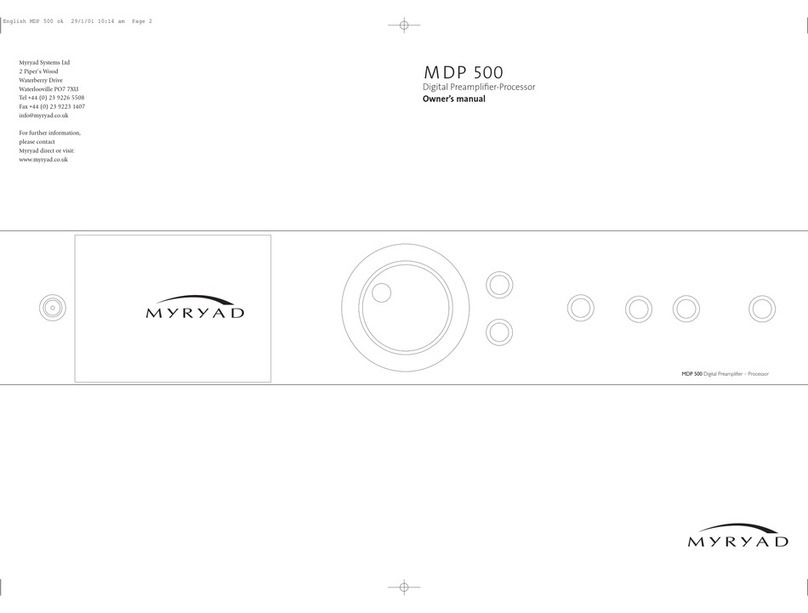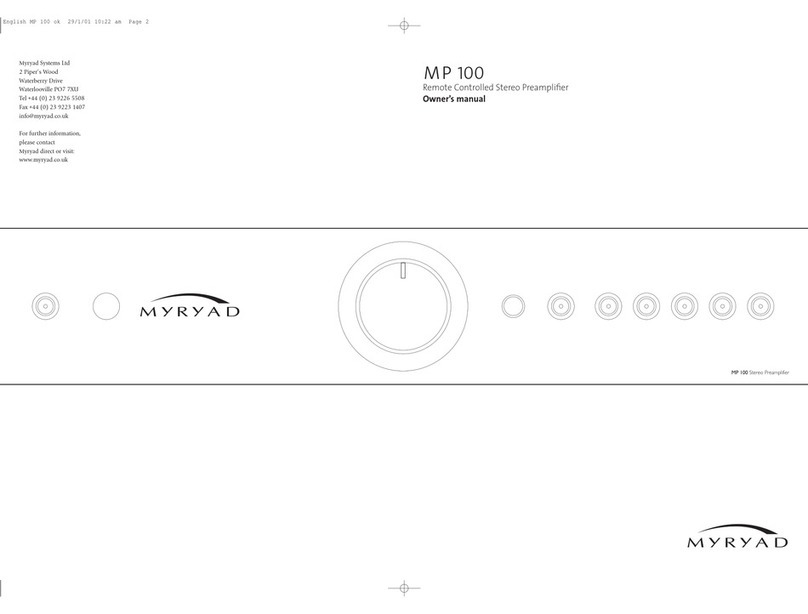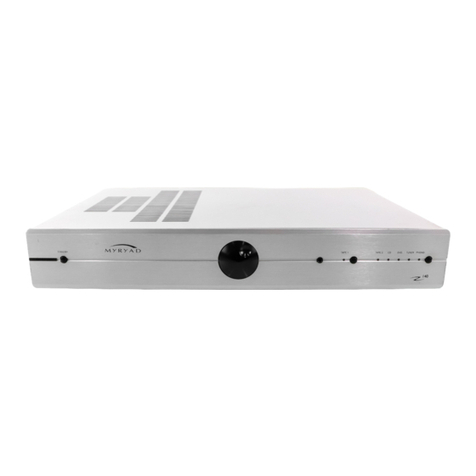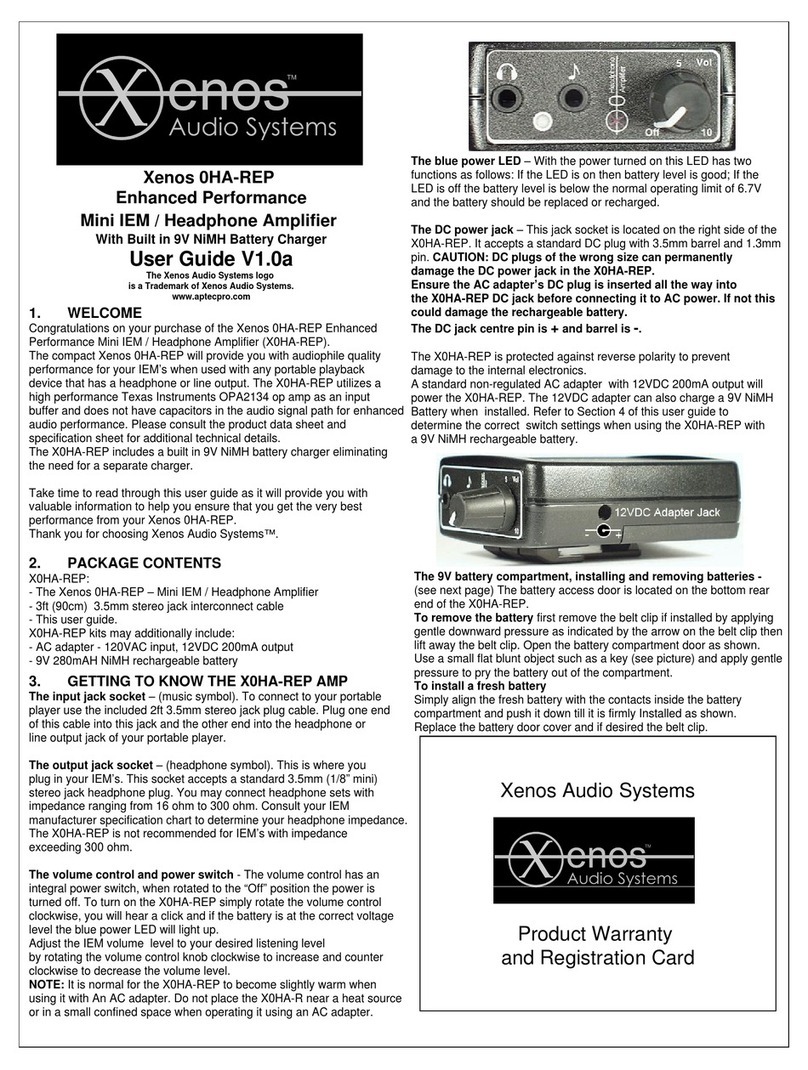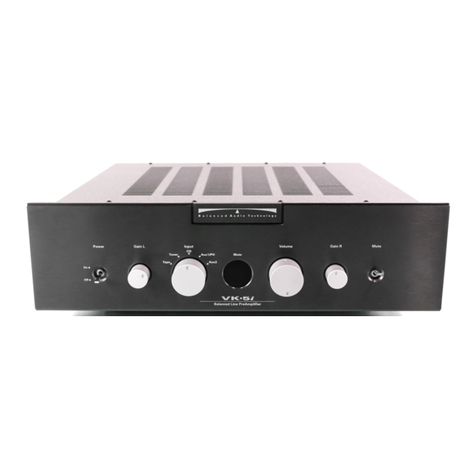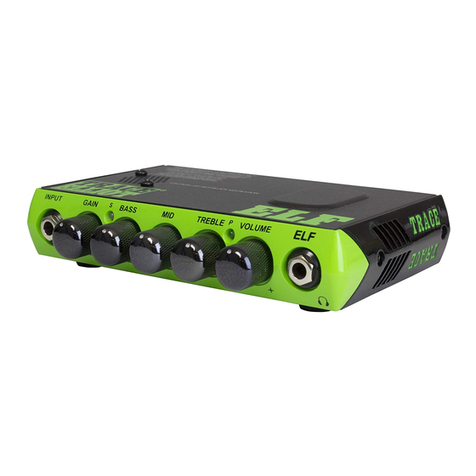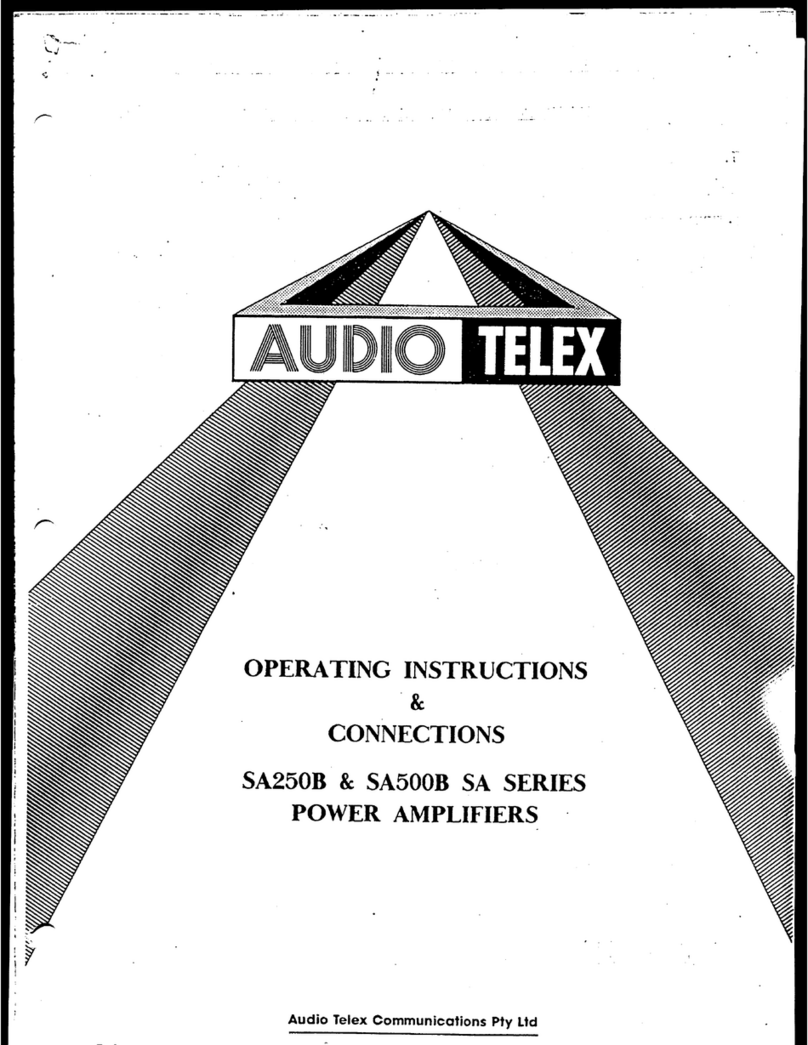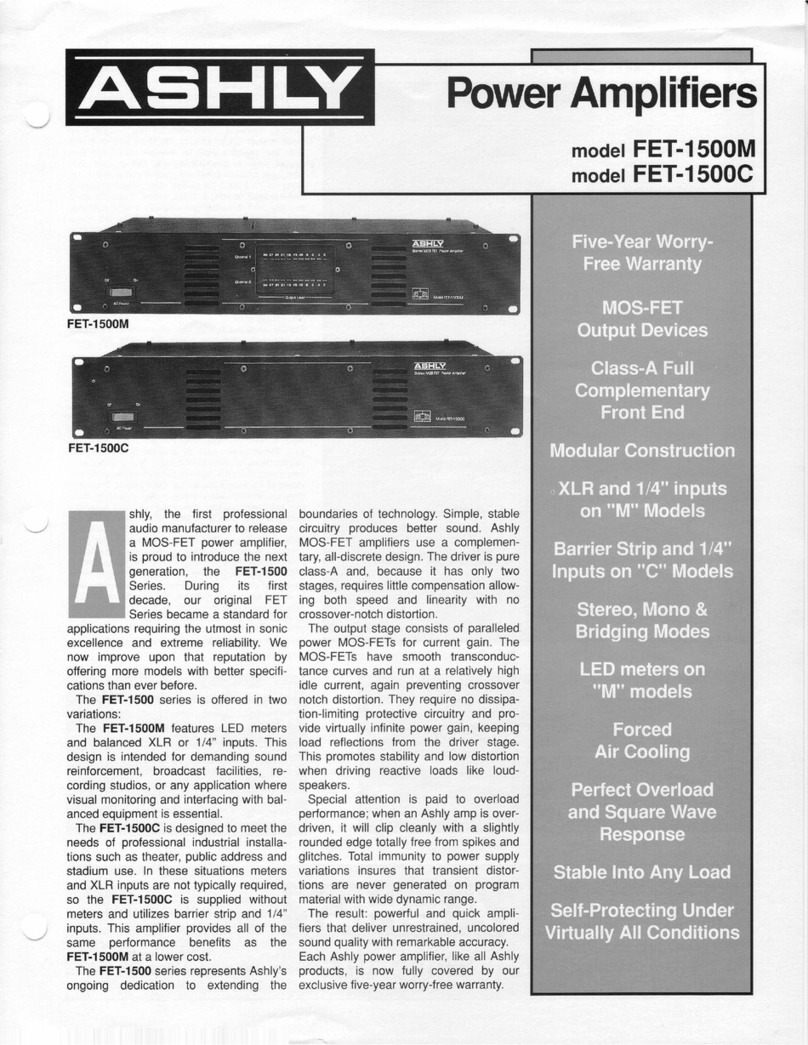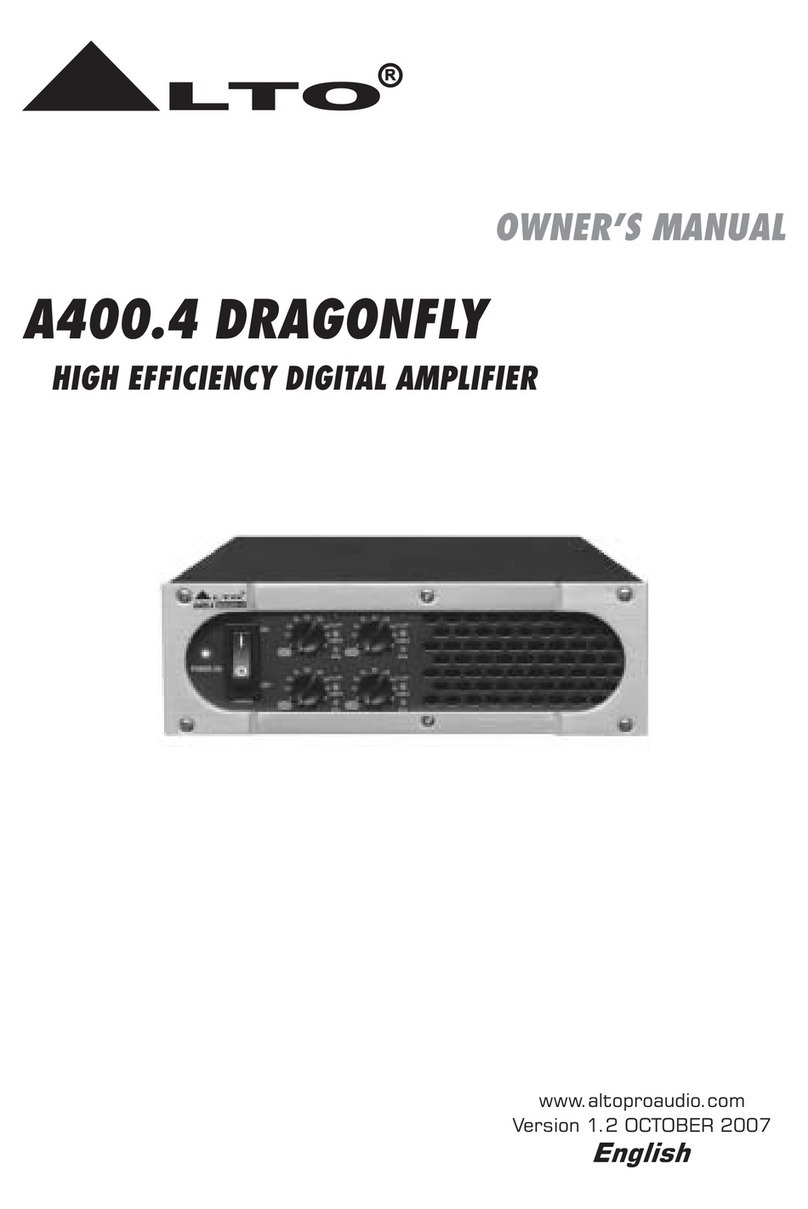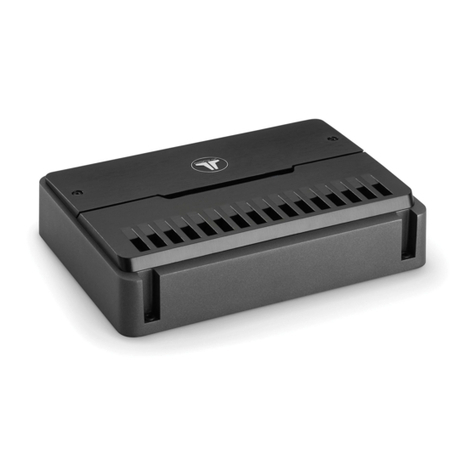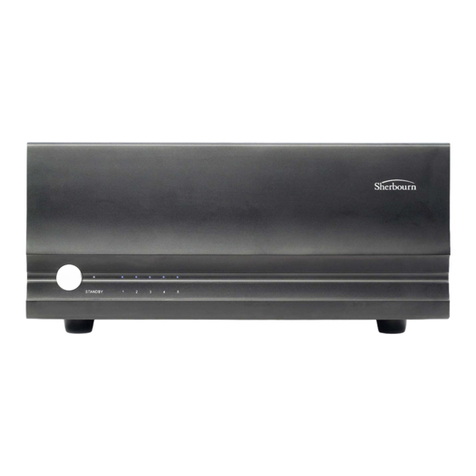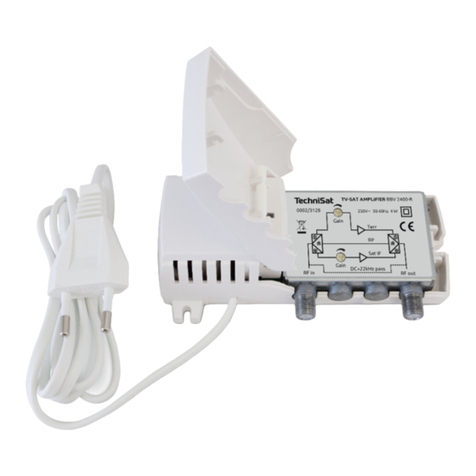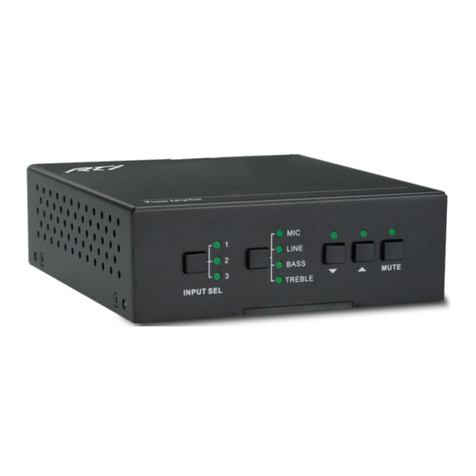Myryad Z142 User manual

Z-SERIES
Z142Remote Controlled Integrated Amplifier
Stortford Hall Industrial Park, Dunmow Road
Bishops Stortford, Hertfordshire, CM23 5GZ
This symbol means do not dispose of as municpal waste.
Re-use or recycle wherever possible. Electrical/Electronic
Equipment may contain substances harmful to the
environment. For environmentally sound methods of disposal,
please contact your local government agency.
Revision: 1
www.armourhe.co.uk
www.myryad.co.uk
Owner’s manual
142

2
CONTENTS
• Introduction 2
• Installation and Safety 2
• Accessories 2
• Setting up your Amplifier 3
Rear panel connections
• Operating your Amplifier 5
Front panel controls
• Loudspeaker Output Protection and Muting 6
• Remote Control Handset Operation 6
• System Operation with Smart My-Link 7
• Installing and Replacing Batteries 7
• Trouble-shooting guide 7
• Specifications 7
INTRODUCTION
The Myryad Z142 Integrated Amplifier has been designed to offer
a combination of high quality sound reproduction and elegant
styling. The Z142 can accept up to six line-level input sources,
including two tape recorders. Outputs are provided for one pair of
loudspeakers, for headphones and for an auxiliary power
amplifier. All functions – input selection, volume and standby –
can be operated using the infra-red remote control handset
supplied.
The Z142 offers a range of expansion possibilities:
• The Smart My-Link® input can be connected to a Myryad CD
player and Tuner – for example - which will automatically be
switched on or off when the Z142 is switched on or off.
• The Smart My-Link® input/output can be coupled to other
Myryad products that can then be remote-controlled via the
Z142's infra-red receiver - or vice-versa.
• When linked via the Smart My-Link® to other Z-Series products
or other compatible Myryad products, a number of extra features
become available which make the system as a whole easier and
quicker to operate.
INSTALLATION AND SAFETY
The Z142 generates a modest amount of heat and requires
ventilation. Do not place it on a rug or other soft surface into
which it could sink, obstructing the air inlets in its underside. Do
not allow any obstruction to the ventilation slots in the top cover. If
a number of Z-Series units are stacked on top of one another, the
Z142 should be placed on top. The Z142 should not be installed
in a built-in situation such as a bookcase or rack unless proper
ventilation is provided.
CAUTION: THIS APPARATUS MUST NOT BE EXPOSED TO
DRIPPING OR SPLASHING. OBJECTS FILLED WITH LIQUIDS
SUCH AS VASES MUST NOT BE PLACED ON THE
APPARATUS.
THE REAR PANEL POWER SWITCH DISCONNECTS MAINS
LIVE ONLY. THE POWER CORD MUST BE DISCONNECTED
FROM THE REAR OF THE APPARATUS, OR THE WALL
SOCKET, TO PROVIDE TOTAL ISOLATION. ONE OR OTHER
OF THESE CONNECTIONS MUST BE READILY ACCESSIBLE
WHEN THE APPARATUS IS IN USE.
Do not remove the cover, or attempt to modify or repair any item
yourself. Refer all servicing to a qualified technician.
ACCESSORIES
Your Z142 is supplied with the following accessories.
• Separate mains power cord to suit country of sale.
• My-Link interconnect (0.5m RCA-RCA).
• MSR2 remote control handset.
• MSR2 System Remote Control Owner’s Manual
• Two AAA batteries for handset (not in some countries).

3
SETTING UP YOUR AMPLIFIER
REAR PANEL CONNECTIONS
1 Power inlet
Before making any connection, check that the mains voltage
setting printed on the rear panel is the same as your local mains
supply. Plug the female (socket) end of the power cord into the
power inlet on the rear of the amplifier. Plug the male (plug) end
of the cord into a “live” wall socket or a suitable heavy duty
extension cable.
2 Power switch
Press one side of this rocker switch (the side nearer the edge of
the rear panel) to switch the amplifier ON and the other side to
switch it OFF. When the POWER switch is in the OFF position all
power is disconnected from the amplifier and it cannot be
powered up from the front panel or the remote control. When the
POWER switch is in the ON position (and the power cord
correctly inserted and plugged in to a live wall socket) the
amplifier will power up in standby mode (see FRONT PANEL
CONTROLS, STANDBY, page 5). It is recommended that the
POWER switch is turned OFF if the amplifier is not going to be
used for an extended period of time.
3 My-Link input/output
When the Z142 is used in a system with other Z-Series products
(or Myryad MX-Series), all may be joined together via the My-Link.
My-Link is a communications bus that allows all the linked
components to operate together as a system and distributes the
remote commands received by any one to each of the others.
The simplest function provided by the My-Link bus is that all
linked units will switch into or out of standby mode when the
amplifier’s front panel or remote control standby key is pressed.
The My-Link bus allows any linked product to be remote-
controlled via the tuner's infra-red receiver - or vice-versa.
The Z142 (or any other product on the My-Link bus) can be
controlled from a remote room via a suitable interface to the My-
Link bus.
Use a short RCA-to-RCA (phono-to-phono) interconnect cable to
connect from the MYLINK OUT socket on the Z142 to the MY-
LINK IN socket on the CD player and a second cable from the
MY-LINK OUT socket on the CD player to the MY-LINK IN socket
on the tuner – “daisy-chain” fashion. Further Myryad Z-Series or
MX-Series products can be linked in the same way, running from
the MY-LINK OUT socket on the tuner. Inexpensive interconnects
may be used as the Smart My-Link bus carries only control
signals, not audio, so these cables have no effect on sound
quality.
When other Myryad products equipped with Smart My-Link® (e.g.
Z-Series or MX-Series) are connected via the My-Link many more
powerful system features are available (see page 7).
4 Loudspeaker outputs
The loudspeaker outputs are capable of driving all loudspeakers
with rated impedances in the range 4Ωto 16Ω. The loudspeaker
terminals are high–current binding–posts, coded red or black. The
terminals on the left side of the amplifier (viewed from the front)
and marked “L” should be wired to the left-hand loudspeaker.
Those on the right, marked “R”, should be wired to the right-hand
loudspeaker.
For correct stereo imaging it is important that the two
loudspeakers are wired “in phase”. To ensure correct phasing
wire the black (–) terminal on the amplifier to the black or “–”
terminal on the loudspeaker. The red (+) terminal on the amplifier
should be wired to the red or “+” terminal on the loudspeaker.
The loudspeakers should be positioned as recommended by the
loudspeaker manufacturer. The two loudspeakers should always
be placed at equal distances from the main listening position and
usually spaced a similar distance apart. It is generally best to
keep the loudspeakers away from room corners and many
loudspeakers work best away from all walls.
5 Bi-amp output
Many loudspeakers today are made so that the bass and treble
sections can be separated and fed from two sets of speaker
cables. This is known as “bi-wiring” and can yield a significant
improvement in sound quality. A further sound quality gain may
be made by “bi-amplifying” the loudspeaker – using two separate
power amplifiers to drive the bass and treble sections.
The Z142 makes provision for this with its “BI-AMP” output, which
can be used to feed a separate Myryad Power Amplifier.
6 Tape 1 input/output
These connectors are suited to any type of tape or CD recorder,
including high-quality “3-head” tape recorders which allow you to
monitor the signal off the tape whilst it is being recorded. Connect
a stereo cable from the TAPE 1 REC output sockets of the
amplifier to the LINE IN or RECORD IN sockets on your tape
deck. Connect a second stereo cable from the TAPE 1 PLAY
input sockets of the amplifier to the LINE OUT or PLAY OUT
sockets on your tape deck.
Any source selected for listening on the amplifier will
automatically be fed to the TAPE 1 REC output sockets for
recording. If the TAPE 2 input is selected then tape copies may
be made from TAPE 2 to TAPE 1. It is NOT possible to copy from
TAPE 1 to TAPE 2.

4
7 Tape 2 input/output
These connectors are suited to any type of tape or CD recorder,
but “off-tape” monitoring is not possible using TAPE 2. The wiring
from TAPE 2 to your tape deck is identical to the TAPE 1 wiring
described above.
Any source selected for listening, except TAPE 1, will
automatically be fed to the TAPE 2 REC output sockets for
recording. It is NOT possible to record from TAPE 1 to TAPE 2.
8 CD input
Connect the audio output cables from a CD player to these
sockets. If you do not have a CD player then any other line level
source may be connected to this input.
Note: this input is for an audio signal, not for the digital output
from your player.
9 DVD input
Connect the audio signal output cables from a DVD player to
these sockets. Use the outputs marked L and R or LF and RF (if
the player has a built-in 5.1 channel decoder). Alternatively, any
other line level source may be connected to this input.
Note: this input is for an audio signal, not for the digital output
from your player.
10 Tuner input
Connect the audio output cables from a radio tuner to these
sockets. If you do not have a tuner then any other line level
source may be connected to this input.
11 Phono/Aux switch
This switch is used to select between the PHONO and AUX
inputs described below. With the switch released (button
protruding) the signals from a record player connected to the
PHONO input will be heard when the PHONO input is selected.
When the switch is pressed in, signals from the AUX input will be
heard when PHONO is selected.
Sources can be left permanently connected to both the PHONO
and AUX inputs and the PHONO/AUX switch used to select
between them if desired.
12 AUX input
The audio output from any line level source may be connected to
this input.
13 Phono input
Connect the audio output cables from a record player to these
sockets. The input is designed for use with moving-magnet or
“high-output” moving-coil phono cartridges. Consult your dealer if
you are in any doubt what type of phono cartridge you have.
14 Ground terminal
This terminal (marked GND) is provided for grounding a record
player connected to the PHONO input. Some record players do
not have a separate ground wire, in which case make no
connection to this terminal.

5
OPERATING YOUR AMPLIFIER
FRONT PANEL CONTROLS
1 Standby
When amplifier is plugged into a live wall socket and the POWER
switch is turned ON, it will power up in “standby” mode and the
LED (Light Emitting Diode) by the STANDBY button will glow red.
In this mode the internal circuitry is powered up, but disabled so
that it consumes very little power and the loudspeaker outputs are
muted by a relay.
When the STANDBY button is pressed the circuitry is activated
and, after a few seconds delay, the audio outputs will be enabled.
During this delay period while the internal circuitry is settling the
STANDBY LED will flash blue. When the outputs are de-muted it
will glow blue continuously. When the STANDBY button is
pressed again the amplifier will be returned to standby mode, the
STANDBY LED will glow red again and all other LEDs and
displays will be extinguished.
When the Z142 is switched out of standby, the input used last is
automatically selected and, after a few seconds settling delay, the
loudspeaker outputs will be connected. When first switched out of
standby after POWER ON, the CD input will be selected by
default.
CAUTION: WHEN IN STANDBY MODE THE INTERNAL
CIRCUITRY IS STILL LIVE, SO ALL SAFETY PRECAUTIONS
MUST BE FOLLOWED.
2 Infra-red receiver
The infra-red (IR) remote control receiver is mounted behind the
window next to the standby LED as indicated. It must therefore
not be obscured when the unit is to be operated using the remote
control handset. Where possible it is best to arrange that the IR
window is in “line-of-sight” of the remote handset. When various
components are connected via the My-Link bus, only one needs
to receive the IR command signals in order to control any of the
linked units.
3 Volume control
The volume control adjusts the sound level of the loudspeakers,
bi-amp output and headphones. It does not affect the signals fed
to the TAPE 1 and TAPE 2 REC sockets so it can safely be
adjusted whilst making a recording.
When the MUTE mode is engaged using the remote control, the
STANDBY LED will flash repeatedly to indicate this condition.
Always press MUTE on the remote handset again to disengage
MUTE before advancing the volume control setting.
4 Headphone socket
The headphones socket will accept a standard 3.5mm stereo jack
plug or adapter. All types of headphones of any impedance may
be used, with one exception: electrostatic headphones are usually
supplied with an adapter unit which must be connected directly to
the loudspeaker terminals. Insertion of a plug into the
headphones socket automatically disconnects the loudspeakers,
silencing them. In order to resume listening to loudspeakers you
must unplug the headphones from this socket. The headphones
output is not muted when switching in and out of STANDBY mode,
so it is recommended that headphones are unplugged from the
amplifier before switching to standby mode and plugged in again
after switch-on.
5 Tape 1 (Monitor) and LED
When you press the TAPE 1 button you can hear the output
signal from a tape deck connected to the TAPE 1 PLAY sockets
on the rear panel. This is a “toggle” function switch: you press it
once to engage and press again to disengage. The blue LED next
to the TAPE 1 button illuminates to indicate that TAPE 1 is
engaged.
Pressing the TAPE 1 button has no effect on any other input
selected. The signal source selected by the SOURCE button will
be fed to the TAPE 1 REC output sockets, irrespective of whether
the TAPE 1 button is engaged or not. Thus, if you have a “three-
head” tape deck that permits off-tape monitoring you can use the
TAPE 1 button to switch back and forth between the source signal
and the off-tape signal, to check its quality, whilst the recording is
in progress.
Note: if the tape 1 button is engaged with no signal source
connected to the tape 1 play sockets, or with no tape running,
then you will hear only silence, regardless of the settings of any of
the other controls.
6 Source select button and LEDs (Tape 2, CD, DVD, Tuner
and Phono inputs)
The SOURCE select button is used to choose which signal
source you want to listen to (apart from TAPE 1 – see above).
The chosen signal source is indicated by one of the blue LEDs to
the left of the source select button. When the button is pressed
the next source is chosen, moving left to right (TAPE 2 CD
DVD TUNER PHONO). If the button is pressed with
PHONO selected the TAPE 2 input is selected next.
The selected source will be sent both to the loudspeakers and to
the bi-amp output, as well as to the TAPE 1 REC and TAPE 2
REC output sockets for recording. The only exception is TAPE 2
which will not be fed to the TAPE 2 REC output sockets as this
could cause dangerous oscillation. Recordings may be made
from TAPE 2 to TAPE 1, but not from TAPE 1 to TAPE 2.

6
LOUDSPEAKER OUTPUT
PROTECTION AND MUTING
When the amplifier is in standby mode the loudspeaker output
terminals are isolated from the amplifier by high quality relays.
When the amplifier is first switched on from standby mode the
loudspeaker outputs remain disconnected for a few seconds
to allow the internal voltage levels to settle. The same
process occurs when the amplifier is switched back into
standby mode. This power-on mute does not disconnect the
headphone socket, so it is recommended that headphones
are unplugged from the amplifier before switching to standby
mode and plugged in again after switch-on.
The same loudspeaker mute relay is used to protect both the
amplifier and your loudspeakers against possible damage. If
any one of a number of fault modes is detected (loudspeaker
outputs short circuit, amplifier overheating, amplifier DC fault)
the loudspeakers will be disconnected from the amplifier to
protect both. In the case of a short circuit or DC fault the
loudspeakers will be re-connected after a few seconds, but
will be disconnected again if the fault persists. If overheating
has caused the protection system to operate, then it will take
some time for the heatsinks to cool sufficiently to allow the
loudspeakers to be re-connected (probably between five and
fifteen minutes depending upon the room temperature and
ventilation). The amplifier will cool more quickly if it is
switched to standby mode, or if the POWER is switched OFF.
REMOTE CONTROL HANDSET
OPERATION
The MSR2 handset supplied with the Z142 has been
ergonomically designed to be easy and comfortable to use. It will
also control Myryad’s Integrated Amplifiers, Preamplifiers, Tuners
and DVD Players. See the separate MSR2 System Remote
Owner’s manual for details of its use with these products.
The handset keys allocated to control of the Z142 are active in all
handset modes and are as follows:
Standby
This key operates in exactly the same way as the STANDBY
button on the front panel.
Vol
and
Pressing one of the VOLUME
or
keys will increase or
decrease the volume setting - in exactly the same way as rotating
the front panel volume control. If the amplifier is in mute mode
(after pressing MUTE on the R/C handset) then pressing the
VOLUME
key will automatically disengage mute mode and re-
connect the signal to the loudspeakers. This prevents an
excessively high volume level from being set by mistake.
Mute
Pressing the MUTE key on the handset will engage mute mode.
The loudspeakers will be disconnected and the blue STANDBY
LED will flash slowly. MUTE is a “toggle” function, so pressing the
key again will disengage the mute mode.
TP1, TP2, AUX, TV, CD, DVD, TUN
These keys allow direct access to input sources. The inputs
selected are as follows:
TP1 selects Tape 1
TP2 selects Tape 2
AUX selects Phono/Aux
TV selects DVD (to maintain backward compatibility with
earlier Myryad remotes)
CD selects CD
DVD selects DVD
TUN selects Tuner
When a new source is selected, the previous source is
automatically cancelled, with the exception of TP1 (Tape 1) – see
below.
TP1 (Tape 1)
When you press the TP1 key you can hear the output signal from
a recording device connected to the TAPE PLAY sockets on the
rear panel. It operates in exactly the same way as the TAPE
button on the front panel. Tape is a "toggle" function; you press
the key once to engage and press again to disengage. The TAPE
input also disengages if a new source is selected either from the
remote or front panel.

7
SYSTEM OPERATION WITH
SMART MY-LINK
®
When used as a linked system (which must include a Smart My-
Link® equipped Integrated Amplifier like the Z142, or a
Preamplifier) Myryad products equipped with Smart My-Link®
have a number of extra features that make the system as a whole
easier and quicker to use than a normal hi-fi. These include:
Start-on-Play (CD)
Press play on the CD player (or the remote control) and both the
CD player and amplifier will switch out of standby (if necessary)
and play the CD. The amplifier will automatically select the CD
source.
Start-on-Open (CD)
Press open/close on the CD player (or the remote control) and
both the CD player and amplifier will switch out of standby (if
necessary) and the CD drawer will open. The amplifier will
automatically select the CD source.
Intelligent Input Selection (Amplifier)
Press a source select button on the remote control and the
system will awaken only the amplifier and the selected source.
Mute/Pause Control (Amplifier/CD)
When using the CD player, selecting mute from the remote
control will mute the amplifier and pause the CD. When the
amplifier mute is cancelled, the CD will continue playing.
Power-Saving Mode (Amplifier/Tuner/CD)
The amplifier will switch the Tuner or CD Player into standby if
either source remains unselected for more than ten minutes.
Automatic Switch-On (Tuner/CD)
If the standby button on the Tuner or CD Player is pressed, the
amplifier will also awaken and select the correct source.
INSTALLING AND REPLACING
HANDSET BATTERIES
The MSR2 Remote Handset uses two 1.5 V type AAA batteries.
To fit new batteries first open the battery compartment in the rear
of the handset and remove any existing batteries. Fit the new
ones as directed by the symbols moulded inside the battery
compartment, then replace the battery compartment cover. The
batteries should always be removed if they are discharged
(indicated by no remote control operation or by operation only at
very short range), or if the remote control is not going to be used
for an extended period.
TROUBLE-SHOOTING GUIDE
Possible solutions to some of the most common problems.
No sound:
• Power turned off or system in standby mode. Check that the
blue STANDBY LED in the amplifier is illuminated and that the
relevant source component is also active.
• An inoperative input has been selected (e.g. CD input with no
CD playing).
• An input has been selected with no source connected.
• Protection relay has operated because of a short circuit
loudspeaker wire or amplifier overheating. Carefully check all
wiring after switching the amplifier POWER OFF to allow it to cool.
• UK version only: The fuse in the mains plug has failed. Check
and replace if necessary.
Sound in one channel only:
• Loudspeaker cable pulled loose. Check all connections, both at
the loudspeakers and amplifier.
• Interconnect cable pulled loose or making poor contact. Check
and, if necessary, un-plug and re-plug all relevant cables.
Loud buzz or hum:
• Interconnect cable pulled partially out of its socket.
• Defective interconnect cable.
For further help please visit Myryad website at
www.myryad.co.uk
SPECIFICATIONS
Continuous rated power output, 8Ω(<0.1% THD) 50W
Signal/noise ratio (A-weighted, ref 50W) 102dB
Input sensitivity (ref 50W) Line inputs:
Phono input:
250mV
2.5mV
Frequency response (20Hz – 20kHz) ±0.3dB
Dimensions (w x h x d) 436 x 78 x 316mm
Weight (net) 6.9kg
Supply voltage (set by internal wiring) 120 or 230V
Finish Natural Silver fascia with Silver Grey casing
or Satin Black fascia with Black Casing.

Z-SERIES
Z142Remote Controlled Integrated Amplifier
Stortford Hall Industrial Park, Dunmow Road
Bishops Stortford, Hertfordshire, CM23 5GZ
This symbol means do not dispose of as municpal waste.
Re-use or recycle wherever possible. Electrical/Electronic
Equipment may contain substances harmful to the
environment. For environmentally sound methods of disposal,
please contact your local government agency.
Revision: 1
www.armourhe.co.uk
www.myryad.co.uk
Owner’s manual
142
Table of contents
Other Myryad Amplifier manuals
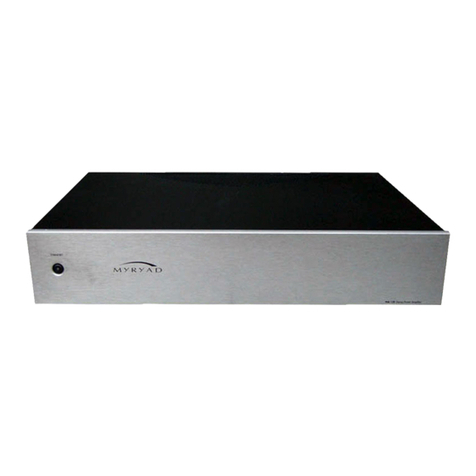
Myryad
Myryad MA120 User manual

Myryad
Myryad MXA2080 User manual
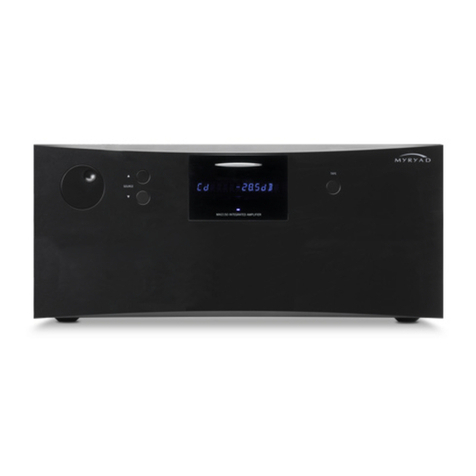
Myryad
Myryad MX Series User manual
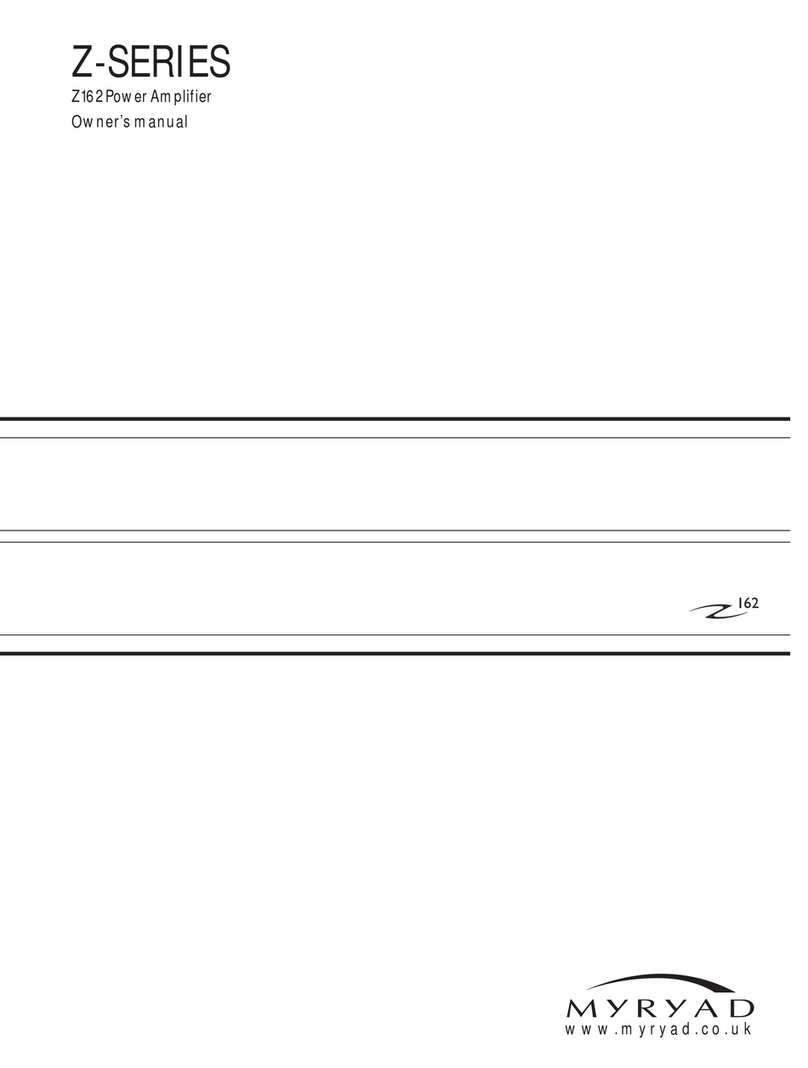
Myryad
Myryad Z162 User manual
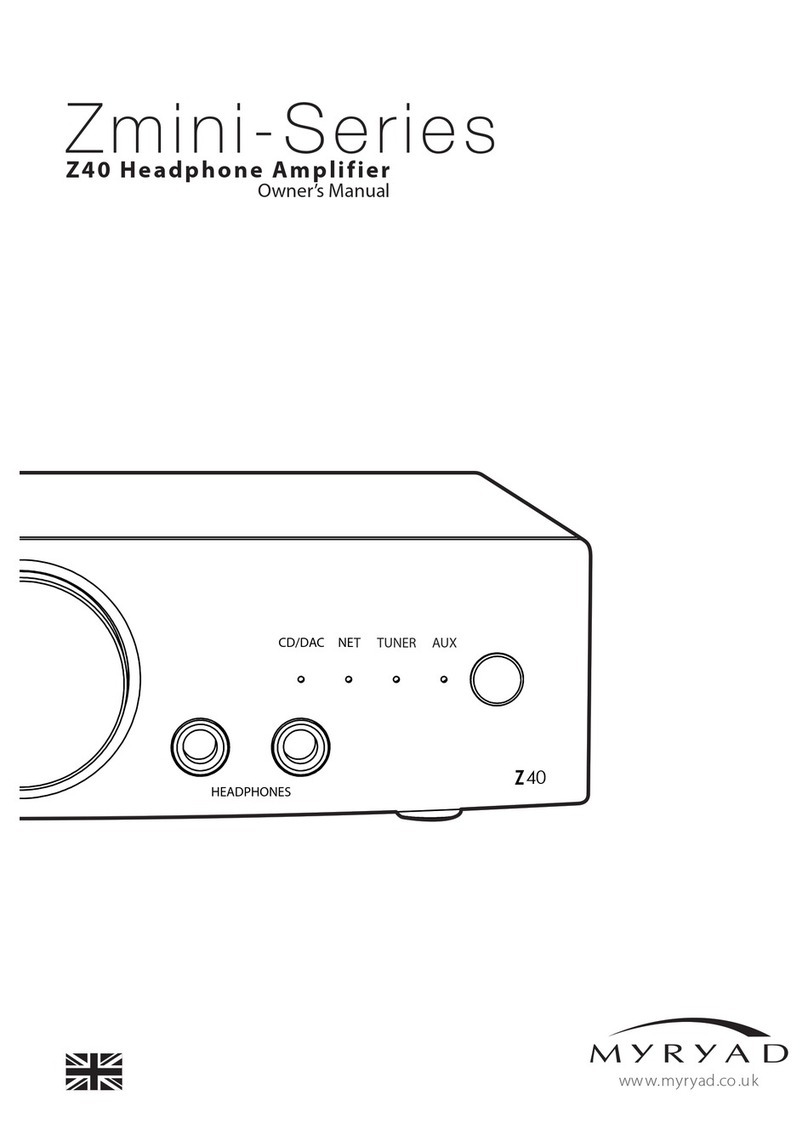
Myryad
Myryad ZMINI Z40 User manual

Myryad
Myryad MI 240 User manual

Myryad
Myryad MA500 User manual

Myryad
Myryad Z Series User manual
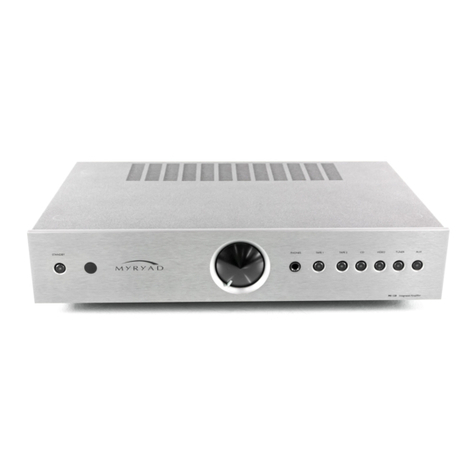
Myryad
Myryad mi 120 User manual
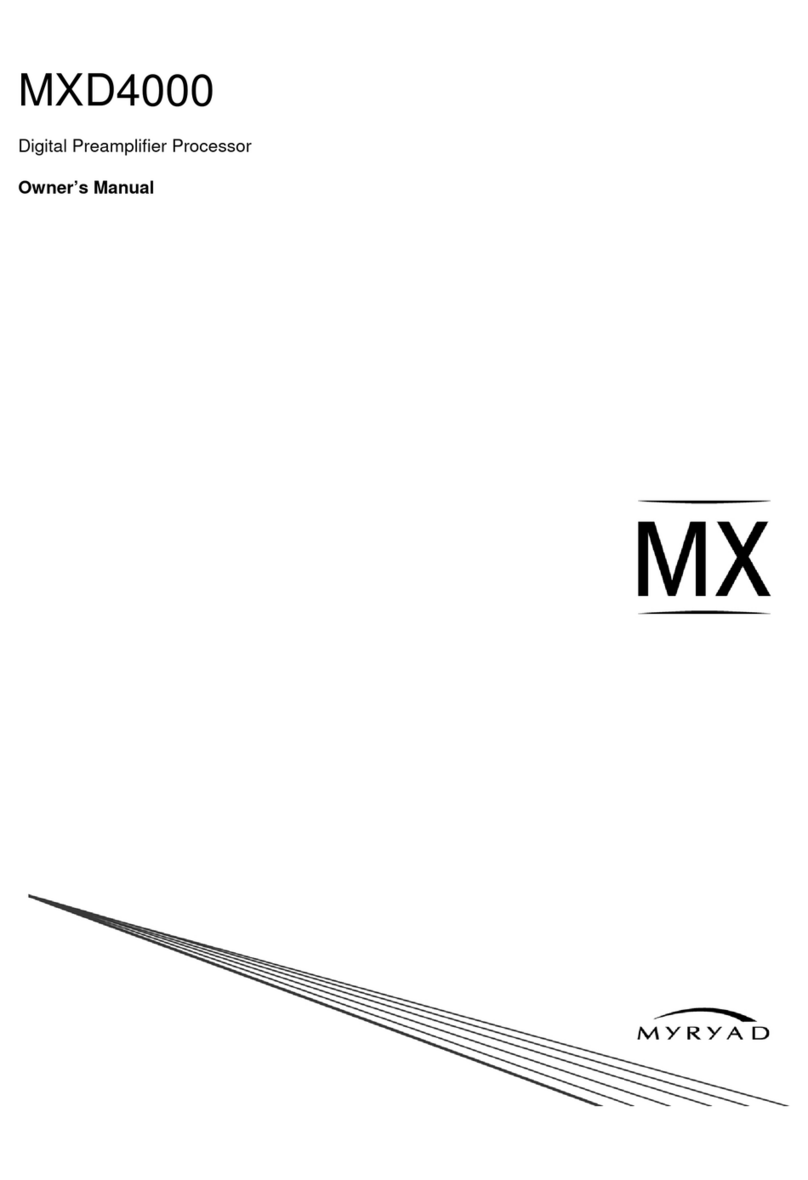
Myryad
Myryad MXD4000 User manual
